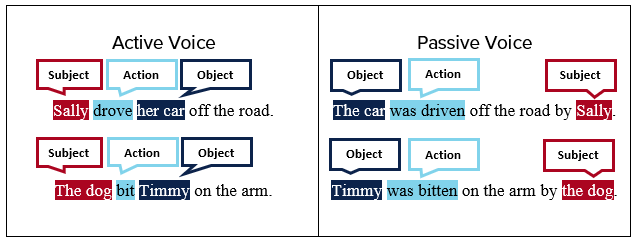Active Vs Passive Voice In Writing
What is active voice?
Active voice is a style of writing that puts the subject at the beginning of the sentence, followed by an action, and then the object that receives the action.
Subject + Action + Object = Active Voice
Why should I use active voice?
The point of the active voice is to highlight the logical flow of the action, from the subject (or doer) to the object (or receiver) of the action. Using this style in your writing will make your sentences clear and direct, which are important components of academic writing.
What does active voice look like?

What are some tips to locate and avoid passive voice?
-
Look for "by" phrases
For example, "by Sally" or "by the dog" might be a sign that the sentence is passive voice. -
Look for a form of "be"
Look for words such as is, was, were, are, or been. These words might signal passive voice. -
Does it make sense?
If you can say the subject, action, and object in the order they appear in the sentence and it makes sense, you have written in active voice. For instance, you can say "Sally drove car" and can understand the meaning. However, if you say "Car driven Sally" it does not make sense; this scenario would indicate that you wrote the sentence in passive voice. -
Use Grammarly
Grammarly can help you identify and correct passive voice. To create your free premium account, follow the steps in the Grammarly Guide.
When am I allowed to use passive voice?
Use the passive voice rarely, and only to serve an intentional purpose. Below are 3 reasons you might intentionally use the passive voice.
-
To direct a reader's focus
Example of intentional passive voice: "References used by students must be cited according to APA conventions."
By phrasing this in the passive voice, the reader focuses on "references" rather than "students" who are formatting the information. -
To maintain objectivity
Example of intentional passive voice: "Reactions to the higher doses of medicine were found by the researcher in all experiments."
By phrasing this in the passive voice, it sounds to the reader that the "reactions" occur regardless of who is doing the research, which is what the writer means. By contrast, "The researcher found" implies the reactions are subjective from one researcher to the next. -
To create a flow in your writing
Example of intentional passive voice: "I tested whether the students would perform better with or without deadlines. These deadlines were selected by dividing the semester into four equal parts. Each part began with prewriting activities and ended with a final draft."
By phrasing the second sentence in passive voice, it allows the writer to flow from already-stated ideas to new points. This use of passive voice not only helps guide the reader to the next idea, but it also varies sentence structure to avoid sounding monotonous by using the same subject to begin each sentence.
Active Vs Passive Voice In Writing
Source: https://writingcenter.uagc.edu/active-vs-passive-voice
Posted by: clementwrapprand.blogspot.com

0 Response to "Active Vs Passive Voice In Writing"
Post a Comment